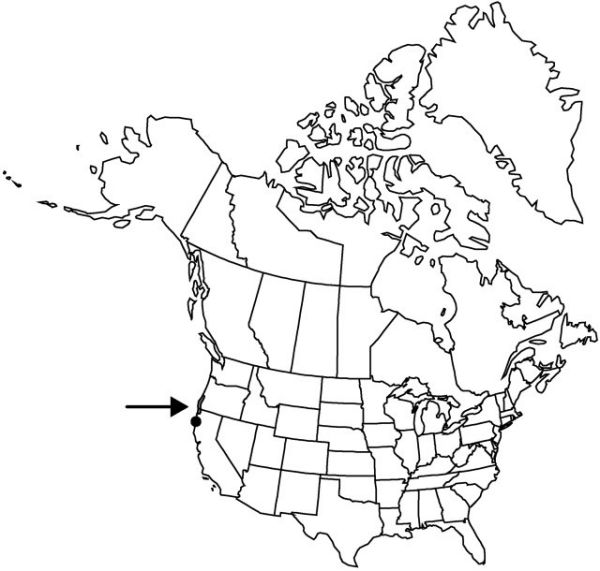Lilium occidentale
Erythea 5: 103. 1897.
Bulbs rhizomatous, sometimes irregular, unbranched, continuously scaly, 1.8–4.3 × 2.1–9.9 cm, 0.3–0.7 times taller than long; scales 1–2 (–3) -segmented, longest 0.9–2.5 cm; stem roots absent. Stems to 2.2 m. Buds rounded in cross-section. Leaves scattered or in 1–9 whorls or partial whorls, 3–19 leaves per whorl, horizontal and drooping at tips to ascending, 4.1–26.3 × 0.4–3 cm, 4–29 times longer than wide; blade elliptic to linear, occasionally narrowly lanceolate, sometimes narrowly or weakly oblanceolate, margins not undulate, apex narrowly acute; veins and margins ± smooth abaxially. Inflorescences racemose, 1–35-flowered. Flowers pendent, not fragrant; perianth Turk’s-cap-shaped; sepals and petals reflexed 2/5 along length from base, yellow, greenish yellow, or green proximally (and usually forming a green star), sometimes with an intercalary band of orange or yellow, then red-orange to red to maroon or very rarely orange on distal 1/2–2/3, maroon, dark purple, or rarely blackish spots concentrated proximally and rarely extending into distal reddish zone, conspicuously green abaxially on proximal 2/5–1/2, not distinctly clawed; sepals not ridged abaxially, 4.4–8.1 × 0.8–1.8 cm; petals 4.3–8 × 0.8–1.6 cm; stamens moderately exserted; filaments ± parallel to style, barely spreading, diverging 4°–12° from axis; anthers dull red, dull purple, or magenta, 0.5–1.4 cm; pollen rust or red-orange, occasionally orange or orangebrown to redbrown; pistil 3–5.5 cm; ovary 1–2 cm; style green, sometimes purple distally; pedicel 5–29.7 cm. Capsules 2.1–5.4 × 1–1.9 cm, 1.4–3.1 times longer than wide. Seeds 141–207.2n = 24.
Phenology: Flowering summer (Jun–Aug).
Habitat: Coastal scrub, coastal prairies, gaps in coastal coniferous forests especially with Sitka spruce [Picea sitchensis (Bongard) Carrière], Sphag-num bogs and marshes in northern part of range
Elevation: 0–100 m
Discussion
Of conservation concern.
In the late nineteenth century, botanist and bulb merchant Carl Purdy employed Native Americans to collect bulbs of lilies and other desirable plants in the area around Eureka, California, and Lilium occidentale was among the species he was brought. After Purdy described Lilium occidentale in 1897, the plant came into great demand. He later (C. Purdy 1937) lamented that almost no plants were available for cultivation. Populations fluctuated in the middle of the twentieth century and frequently declined dramatically from overcollecting following publicity that the plants had recovered and flowered. Much habitat was subsequently lost to ecological succession and land conversion. Fortunately, several large populations have recently been discovered near Crescent City, California, and completion of a recovery plan (Fish and Wildlife Service 1998) bodes well for the future of this state and federally protected plant.
Lilium occidentale occurs in scattered populations from Humboldt Bay, California, to Coos Bay, Oregon, always within six kilometers of the ocean. Plants near Humboldt Bay occur in coastal prairies and scrub, whereas many Oregon populations are found in sphagnum bogs. Typical Oregon and extreme northern California plants in the vicinity of Crescent City (Del Norte County) have an irregular bulb that occasionally is nearly erect (0.3–0.7 times taller than long versus 0.3–0.5 in Humboldt Bay plants). In northern plants the leaves are often scattered—though they are whorled in larger plants—and extremely long and thin [4.2–26.3 × 0.4–2.7 cm (4.6–28.6 times longer than wide) versus blade 4.1–18.9 × 0.7–3 cm (4–17.4 times longer than wide)] in Humboldt Bay plants. Flowers of Oregon plants are marginally smaller, have somewhat narrower sepals (4.4–7.6 × 0.8–1.5 cm) than Humboldt Bay plants (4.4–8.1 × 1–1.8 cm), and typically appear somewhat later. These differences have provoked discussion about the merits of subdividing this species, but many of the differences appear to be related to habitat rather than genotype. For example, plants from Shores Acres State Park in Coos County, Oregon, occur in a coastal bluff setting that is similar to habitats near Humboldt Bay, and these lilies share many of the same vegetative and floral characteristics of Humboldt Bay plants. Subspecific differentiation appears to be unwarranted.
Lilium occidentale is distinguished from similar species such as L. pardalinum by the closely parallel stamens and adaxial green star formed by the conspicuously green sepal and petal bases, a characteristic also discernible in the abaxial surface of the buds. This green star is present in nearly all flowers when first opened, but changes to yellow or yellow-orange as the flowers age. The green star of certain eastern taxa (e.g., L. superbum) is also diagnostic for them but is primarily formed by glossy green adaxial nectaries and is not so prominent in bud.
Frequent hybrids with Lilium columbianum in Oregon occur primarily where human disturbance has introduced that species into boggy areas via drier open pathways such as powerline right of ways and roads.
With the likely exception of Lilium canadense, L. occidentale is the only North American pendent lily that is pollinated almost exclusively by hummingbirds (in California primarily the Allen’s hummingbird [Selasphorus sassin (Lesson), family Trochilidae]). Its pendent red flower is transitional between butterfly-pollinated forms like L. pardalinum and the classical bird-adapted flowers of L. maritimum and L. bolanderi that are more tubular and horizontal.
The Karok ate Lilium occidentale bulbs after baking them in an earth oven (D. E. Moerman 1986).
Selected References
None.
Lower Taxa
"broad" is not a number."wide" is not a number."thicker" is not a number."elongating" is not a number.

